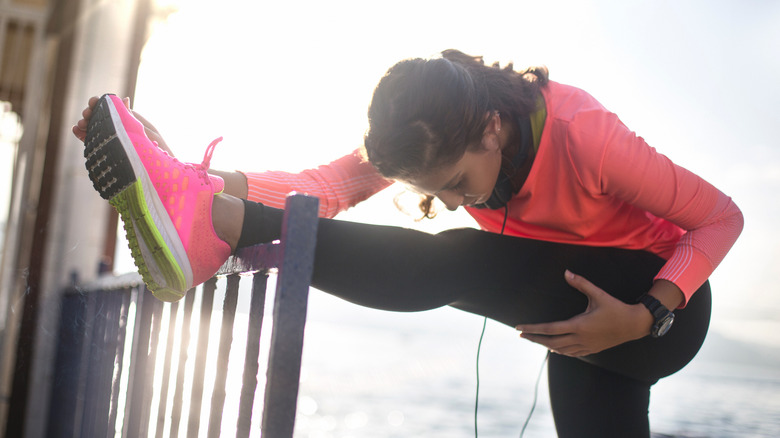Stretching Before These Two Exercises Won't Help Prevent Injury
Your favorite (or maybe least favorite) gym teacher probably rammed this idea into your head — don't forget to stretch! Although stretching might be the first thing we skip when we're in a rush to finish our workout, flexibility is important to reduce injury, according to the National Academy of Sports Medicine. Stretching can also iron out any imbalance in your muscles that can interfere with your form. You'll also improve your range of motion, allowing your muscles (rather than your tendons and joints) to fire your movement.
While a good stretching routine a few times a week can help with your fitness and prevent injury, you might want to skip stretching before certain types of workouts. A 2013 review in the Scandinavian Journal of Medicine & Science in Sports found that your strength, power, and performance can suffer if you do static stretching before exercise. In particular, stretching before a run or a swim doesn't do much to prevent injury. However, it doesn't mean you should rule out stretching altogether.
Stretching for runners
According to a 2011 review in the Cochrane Database of Systematic Reviews, stretching didn't reduce lower-body injuries in different levels of runners. However, many of the studies on stretching and injury prevention for runners use different stretching techniques such as static or passive stretching and different lengths of time to hold the stretch, according to a 2010 study in Current Sports Medicine Reports.
It's possible that dynamic stretching (rather than static stretching) before running could improve endurance running performance, according to a 2015 study in the Journal of Strength and Conditioning Research. Dynamic stretching usually involves moving a joint quickly through a specific range of motion, such as flexing your knee joint while standing so your foot kicks your butt. Compared to runners who didn't stretch, the dynamic stretchers could run longer to exhaustion.
Runner's World also suggests saving those longer, passive stretches for after your run to help your body cool down while also improving flexibility. Stretch your hamstrings, hip flexors, quads, and calves for at least 30 seconds per leg.
Flexibility for swimmers
If you watch swimmers before their races, you might see them shaking their legs and rapidly moving their arms. That's because it's important for swimmers to get the blood moving to their limbs before their short event. Some swimmers will warm up in the pool for a while to elevate their core temperature, according to a 2014 review in Sports Medicine. In fact, a 2019 study in Isokinetics and Exercise Science found that warming up in the water was better than static stretching to improve 50-meter swim speeds.
Even if you're not a competitive swimmer, MIT Recreation suggests dynamic stretches before jumping into the pool. While holding your arms like goal posts, squeeze your shoulder blades together while moving your elbows back and repeat 10-15 times. Another dynamic exercise to try before swimming is to rotate your shoulder through its full range of motion. Draw 25 large circles with your arm straight, feeling a gentle opening of your shoulder joint with the movement.



